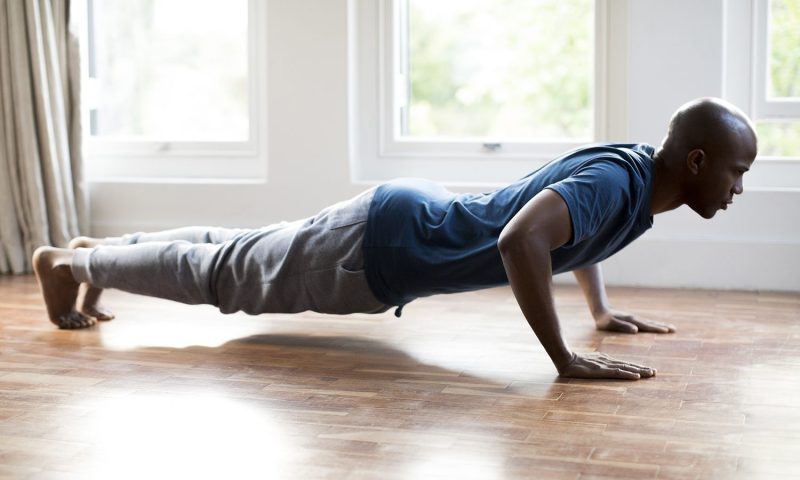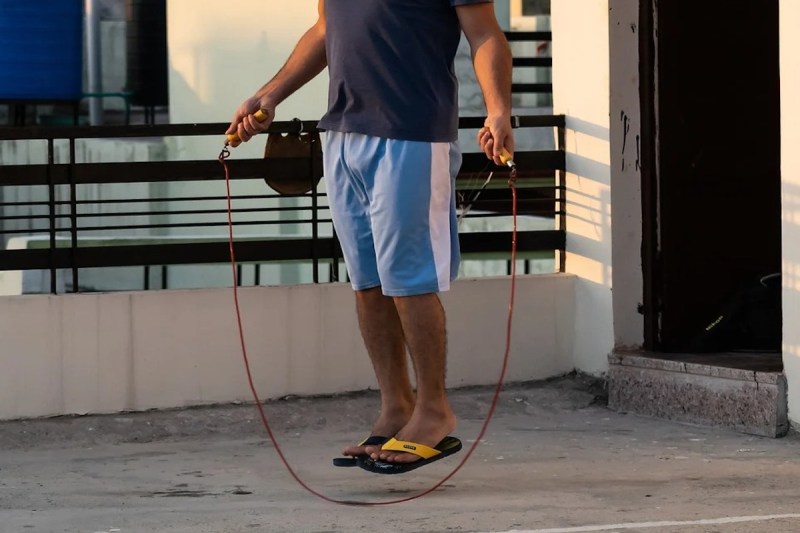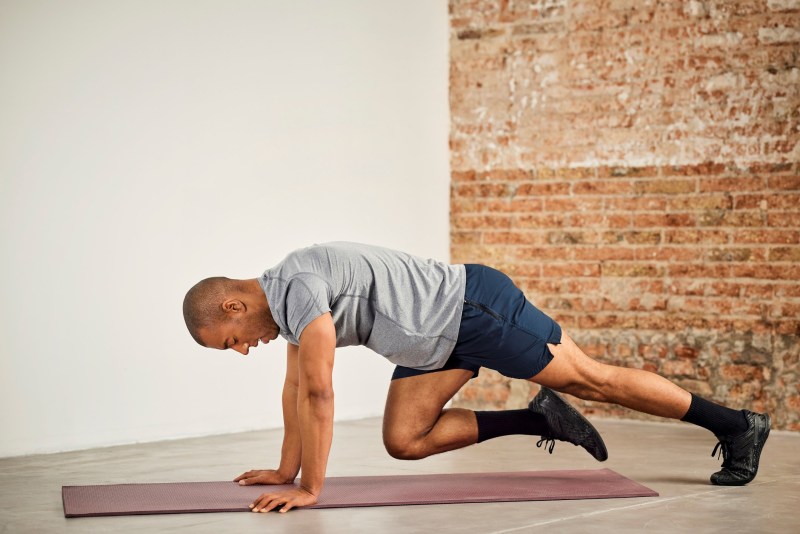
When the winter weather sets in, not only can it be extremely unpleasant to go for a run or bike ride outside, but it can also be unsafe. Between the darkness in the morning and night and the slippery roads peppered with patches of black ice or snow, exercising outside in the winter can sometimes be a dangerous minefield to navigate. However, as much as we may want to, we shouldn’t use the frigid temperatures, slippery footing, and lack of safe lighting to serve as excuses to get out of our fitness routines; rather, there are ways that you can modify your workouts on days when the weather is particularly sour or your gym is closed due to a winter holiday. The best one? Try an at-home cardio workout.
Cardio workouts at home won’t necessarily provide you with all of the potential training benefits of going for a 5- or 6-mile run or doing a vigorous HIIT workout on the elliptical at the gym, but some exercise is almost always better than none. Even better, there are many at-home cardio workouts you can do with little to no exercise equipment. If you don’t have a treadmill or indoor cycle at home to use when the temperatures plummet but you still want to move your body and work up a good sweat, keep reading for the best at-home bodyweight cardio workouts.

What is an at-home cardio workout?
A cardio workout, also referred to as aerobic exercise, is any type of physical activity that increases your heart rate and strengthens your cardiovascular system. What exactly qualifies as “cardio exercise“ though? According to the CDC), moderate-intensity cardio exercise elevates your heart rate to 50%-70% of your maximum heart rate while vigorous-intensity exercise elevates your rate to 70%-85% of your maximum heart rate.
These “moderate-intensity” and “vigorous-intensity” aerobic exercise designations are important because there are different guidelines as to how much of each intensity of exercise you need to reduce your risk of lifestyle diseases. The CDC advises that adults get either 150 minutes of moderate-intensity aerobic exercise or 75 minutes of vigorous-intensity cardio exercise per week.
For an at-home cardio workout to be effective, you need to increase your heart rate to at least 50% of your maximum heart rate throughout the workout. Wearing a heart rate monitor or fitness watch that uses wrist-based heart rate monitoring can be a useful way to ensure that you’re pushing your body hard enough.
Usually, it’s best to aim for 20 to 45 minutes per at-home cardio workout, depending on the intensity of the workout and your fitness goals. The higher the intensity, the more efficient the workout will be. For example, studies suggest that high-intensity interval training (HIIT) workouts can provide the same cardiovascular and metabolic benefits of moderate-intensity, steady-state aerobic exercise in 40% less time. So if you’re short on time and just want to squeeze in a quick workout, dial up the intensity and take on a Tabata or HIIT workout.

8 at-home bodyweight cardio workouts
Below are some at-home bodyweight cardio workouts that don’t require any exercise equipment. All you need is your water bottle, a timer, and some space to move. If you have a heart rate monitor, strap it on so that you can monitor your effort level.

4-minute screamer lunges cardio workout
Screamer lunges are more of a cardio workout than “normal” lunges, as they involve you lifting one knee to hip height and jumping in the air. The jumping motion gets your heart rate up and you’re using your body weight and no equipment. Screamer lunges help build the leg muscles while getting the heart pumping.
Here’s how to perform screamer lunges:
- Stand with your feet hip-width apart.
- Extend your right leg back to the normal lunge position.
- Push off with your right foot to lift your right knee to hip height, and then jump in the air while doing so.
- Return your right foot to the starting position and repeat for 2 minutes lunges on one side.
- Repeat with the left leg for 2 minutes.
Alternative: Do 1 minute with each leg and then repeat 1 minute with each leg, for a total of 4 minutes.

20-minute up-and-down running workout
This is a great equipment-free cardio workout that requires nothing but an area to move in, preferably one that’s about 6 feet by 6 or 7 feet.
You will alternate between two basic, but challenging, bodyweight exercises: Sprinting in place with high knees and mountain climbers with your hands on the floor in a pushup position.
The “up-down” comes into play because you are essentially running upright in a vertical position and then running horizontally when you are down on the ground in the mountain climber position.
Perform each move for 60 seconds and then switch, cycling continuously between the two exercises without taking a rest between rounds. If you’re a beginner, it’s okay to take a breather between the 60-second bouts of each movement. As you build up your endurance, try to do away with rest and continue moving throughout the entire 20 minutes.
You will perform 10 complete rounds for a full 20-minute workout.

16-minute Tabata-style workout
Tabata is a specific style of HIIT that involves performing eight rounds of 20 seconds of all-out exercise followed by 10 seconds of rest, for a total of four minutes.
You can do Tabata with any type of exercise, and even just a single four-minute Tabata session can be an effective workout. However, if you’re in good shape and used to longer cardio workouts, this is a four-part Tabata routine that will involve doing four different exercises for one complete set and then moving onto the next.
For each set, complete eight rounds of 20 seconds of exercise followed by 10 seconds of rest.
- Step 1: Burpees.
- Step 2: Up-down plank. Alternate between the forearm plank position, then press up into a pushup position, one arm at a time.
- Step 3: Alternating jumping lunges.
- Step 4: High knees sprinting in place.
This workout should get your heart rate up to near-max levels and will absolutely challenge your mental fortitude.

10-minute OTM tuck-and-jump cardio workout
Like the up-down running cardio workout, this is a simple but effective bodyweight cardio workout that involves another cycle of two metabolic exercises: tuck jumps and jump squats.
To perform a tuck jump, stand in an upright position. Using your core and glutes, drive your legs up together in tandem so that you jump into the air in a tuck position, with your knees drawn up to your chest. You then should land softly, using your muscles to soften your landing.
To perform a jump squat, get into a basic bodyweight squat. Keep your hips back and bend your knees until your thighs are parallel to the ground. Then perform a vertical jump, reaching as high as you can toward the ceiling before landing back into the squat position.
In this workout, you will cycle between these two plyometric exercises. However, because they are both extremely demanding on your muscles and cardiovascular system, rather than going for a full 60 seconds and then switching to the next exercise without a break, you will perform 15–20 reps of each exercise (depending on your fitness level) beginning at the start of every minute and then resting until the next minute begins.
For example, if you’re a beginner, perform 15 tuck jumps to start. Let’s say this takes you 30 seconds. You will then rest for the final 30 seconds of the minute. At the one-minute mark, you will begin 15 jump squats. If it takes you 35 seconds to get through your repetitions, you will then rest the final 25 seconds of that minute and then begin your tuck jumps again. Advanced athletes should strive for 20 or more repetitions per exercise, aiming to be moving for about 45 seconds of each minute and then resting for 15 seconds. Continue cycling through your exercises for 10 minutes.

20-minute jump rope cardio workout
Even if you don’t have a jump rope, you can simulate jump roping by performing the movement with an invisible rope. Jumping rope is a fantastic cardio exercise and a quick way to get your heart pumping.
Warm up by jogging in place for two minutes. Then jump rope quickly for 90 seconds, then 30 seconds of slow, gentle jumping. Complete eight sets. Beginners can rest for those 30 seconds instead if desired, but but intermediate and advanced athletes should continue jumping at a slower cadence for those final 30 seconds. After eight rounds, begin your cool down by marching in place for two minutes.
Whether you’re jumping with a real rope or simulating the movement, try to land light on your feet and take rapid, low jumps rather than slow, high jumps. You should be aiming for at least 100 jumps per minute.

30-minute bodyweight cardio workout
Many bodyweight exercises are great not only in terms of the cardio component, but also how they can strengthen your muscles. This is a total-body workout that works most of the major muscles in your body while burning calories and increasing your heart rate.
You will complete three rounds of the following 10 bodyweight cardio exercises, aiming to take little to no rest between each exercise to keep your heart rate elevated the entire workout:
- 60 seconds of jump squats
- 60 seconds of high knees sprinting in place
- 60 seconds of alternating jumping lunges
- 60 seconds of burpees
- 60 seconds of jumping jacks
- 60 seconds of mountain climbers
- 60 seconds of crab kicks (crab walk position, alternating kicking legs up)
- 60 seconds of tuck jumps
- 60 seconds of crossover mountain climbers (right knee towards left shoulder, left knee towards right shoulder)
- 60 seconds of seal clap jumping jacks (arms come straight across your chest parallel to the floor and clap in the middle)

30-minute stair-running workout
Running or brisk walking up stairs can be a great way to elevate your heart rate, strengthen your legs, and burn calories. If you have a flight of stairs in your home or you live in an apartment building with a stairwell, you can easily get a great heart-pounding cardio workout at home.
Simply warm up by walking up and down the stairs for three minutes, gradually increasing the pace. Then, set a timer for 25 minutes and run up and down the stairs as many times as possible. Depending on your fitness level, coordination, and balance, you could choose to walk briskly instead. Be careful with your footing and focus on driving your knees up as you ascend the stairs and landing lightly on your feet, as if stepping on hot coals, on the way down.

40-minute no-equipment cardio workout
This 40-minute cardio workout involves performing a simple circuit of six bodyweight calisthenics. If you are a beginner or don’t have a full 40 minutes, you can shorten the workout by doing fewer rounds.
Begin by warming up with two minutes of jogging in place or jogging around your home.
Then, complete six rounds of the following bodyweight cardio exercises:
- 60 seconds of high knees sprinting in place
- 60 seconds of jumping jacks
- 60 seconds of fast feet (squatting down in an athletic stance position, legs wide, alternating weight bearing between one foot and the other as quickly as you can)
- 60 seconds of mountain climbers
- 60 seconds of burpees
- 60 seconds of side-to-side hops over a line
Remember, even when your gym is closed because of a winter holiday or a bad snowstorm keeps you from pounding the pavement on your favorite running route, you can get a great cardio workout at home with just your body weight and a hefty dose of energy!



